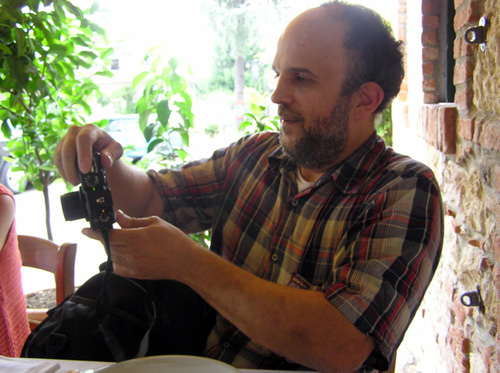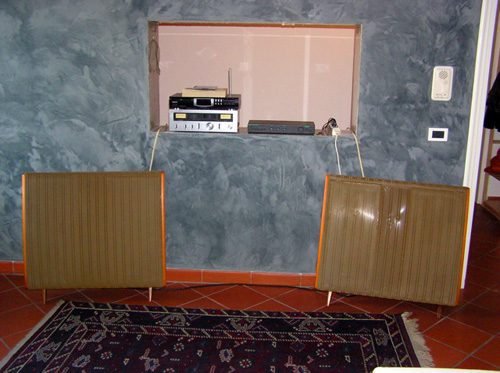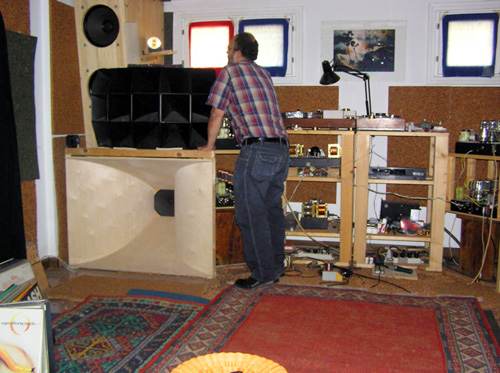 December 2009
Getting It Done in Dueville: A Visit
with Amedeo Schembri of Viva Audio
These past half-dozen years, I’ve become
enamored of Italian culture -- its rich history of art from medieval times up to the
present, the fabulous textures and tastes of its food, the articulate landscape of its
bucolic countryside, and, most of all, the manner in which all of Italian culture
seems subtly interfused with every event that takes place there. For example, the lavishly
delicate taste of a spiny, spotted fish called the San Pietro (Zeus faber, aka St.
Pierre, aka John Dory), usually caught in deep Mediterranean waters, recalled to me the
16th-century architecture of Andrea Palladio -- I’d spent the morning before this
luncheon crisscrossing Vicenza by car, stopping to gaze at a magnificent villa in the
hills above, then to admire grand façade of an ancient civic building, and finally to
circumambulate a palazzo’s imposing rotunda. I felt the boulevards and pedestrian
walkways of the Centro Storico as I ate the San Pietro, named after the apostle Peter, who
became a fisher of men, and as I tasted the freshness of the Pinot Grigio, like a
liquefied autumn morning ordered up by my Italian host. The Italians have a certain way of
integrating and enjoying life. "They takes they time," as a basketball
player said to me once, an American forward in the Italian pro league, while we spoke on a
trans-Atlantic flight. "And they likes they food slow." The best reproduced
sound is like this -- subtly interfused with the tactile splendors of the music, all to be
slowly savored, as one might a fine meal.

Amedeo Schembri of Viva Audio.
|
I recently experienced such a day in Veneto, the Northeast
region of Italy that comprises the area from around Venice to Verona; at a restaurant in
Bassano-di-Grappa, with its wooden bridge (designed by Palladio) spanning the Grappa
River; and at the home of Amedeo Schembri, chief designer of Viva Audio.
Viva has become well known not only for its superb tube
electronics, including zero-feedback single-ended-triode (SET) amplifiers with
point-to-point wiring, but also for great industrial design featuring custom automotive
paints and bold, M-shaped chassis that never fail to impress, visually and sonically.
I’d been curious about Viva ever since I first heard their 28Wpc Solista integrated
amplifier in a showroom some years ago, and since then have checked out their gear at
every national and international trade show I’ve attended. I’ve never been
disappointed.
"It’s about the sound," Schembri said as he
poured red wine into my glass, watching it swirl and spume up inside the hiplike curves of
the glass’s bell, then settle back before he finished pouring. We were having lunch
outside, under a latticed arbor of curling vines, the warm noonday sun seeming to light
everything from within. "You can research and discuss and make up any kind of surrrkits,
but you must test this against the ears to be sure you are not crazy, and you get
somethings that is music, and not just some noise from Electric Street."
We’d driven a few miles from Schembri’s home in
Dueville, a new, residential suburb of Vicenza, to a lovely restaurant at the end of a
church street on the outskirts of Bassano. My wife, Shelly, and our four-year-old
daughter, Annalena, had come along, and we were joined by Joelle De Jaegher, an
accomplished and busy architect and Schembri’s fiancée. It’s Joelle who’s
responsible for the sleek, postmodern look and vibrant automotive colors of Viva’s
electronics. As we spoke, Schembri took photos with a vintage Contax rangefinder -- a film
camera. For a youngish man -- I guess him to be no more than 45 -- he has a definitive way
of speaking; an insistent, discriminating manner of expression that I’ve found
characteristic of many accomplished audio engineers. He spoke authoritatively about
cameras -- SLRs, rangefinders, digital vs. film.
Our talk was also of schools, of the fine dishes we were
eating -- linguini nere, a pasta rendered black by the inclusion of
squid ink; the homey regional dish bacalà, a dried cod reconstituted in milk; and
a delicious astiche, or lobster -- and of audio. De Jaegher encouraged us to send
Annalena to an Italian school during a long stay in Italy we’re planning for 2011 --
something she’d done herself as a child, after moving here from Belgium with her
parents.

Schembri’s living-room system, complete with Quad
ESL-57 loudspeakers.
|
Lunch concluded two hours later (they takes they time)
and we split up, De Jaegher returning to her work designing a chain of boutique shops,
Shelly and Annalena driving to Vicenza to shop, and Schembri and I driving, in his Volvo,
back to Dueville. First, in his living room, he showed me a simple, straightforward system
built around a pair of vintage Quad ESL-57 speakers powered by conventional, solid-state
electronics. Then he ushered me downstairs into his basement -- he calls it il stregone,
the sorcerer’s den -- where we were to hear what he called his "experimental
system." But then Schembri turned hesitant, humble, even worried.
The basement was no artfully decorated, palatial listening
room, but a crowded warren of speakers and electronics at one end, overlapping area rugs
amidships, and, at the other end, racks of LPs, stacks of CDs, stools, folding chairs, and
a fat, worn easy chair. Light streamed through a row of papered-over windows that tilted
open over a long bench strewn with electronics, and spider webs of wires spread into every
cranny and corner. This indeed was Schembri’s workshop: eight prototype tube amps
laid out on four unfinished chassis (two per channel), their transformers exposed; an
assortment of speakers made by hand and scrounged from history; and a Frankenstein’s
machine of an analog rig, comprising a Lenco drive, a custom turntable, a 12" Ikeda
437 tonearm, and a Transfiguration Orpheus cartridge. His CD player was a Viva prototype
too. This was a two-channel, eight-amped, four-way system.
"We are making our own speakers, and these new
amplifiers, as well," Schembri said, gesturing to a large stack in the front right
corner. He declared that he was studying the influence of power supplies on the various
amps. Then he explained that the speaker array consisted of a 15" woofer shared by
both channels; two unfinished, handmade midbass horns; a pair of old Vitavox midrange
horns (the black beehive famously used by Pink Floyd); and, finally, two magnesium
tweeters from Fostex. Tucked behind each speaker stack were the amplifiers: each chassis
housed two amps, 845 output tubes driven by 211 tubes. It seemed a system almost better
suited to a concert than a listening room -- each speaker stack was larger than a
conventional home entertainment center. But I reserved judgment. It’s all about
the sound, I reminded myself.
Schembri put on Miles Davis’s Kind of Blue --
"The original," he proudly announced. What I heard were pleasingly saturated
notes, fulsome timbres, and distinct separation of the soloists -- John Coltrane’s
tenor sax on the left, Cannonball Adderley’s alto on the right, Miles’s trumpet
emerging out of sweet silences. But, I thought, sweet and susurrous though it was, this
was still small-combo jazz -- no sweat. After all, I’d heard this recording sound
good in small rooms with First Watt solid-state amps and single-driver Fostex horns.
Then, no longer shitting around, Schembri brought out a
recording I did not know -- Mussorgsky’s Boris Godunov, with Herbert
von Karajan conducting the Vienna Philharmonic. I’d often read about this opera but
had never heard it. Boy, was I in for it. Nicolai Ghiaurov’s bass voice was so
stunning, rich, and powerful, that, I have to say, I’d never heard anything like it
before -- except in concert. Schembri’s experimental system reproduced the entire
range of Ghiaurov’s bass without any "letterboxing" -- that is, the bottom
wasn’t lost to murk or imagination; the sweet, sub-tenor top wasn’t etched, and
caused no ring or overhang; and all vocal harmonic overtones were rendered with breadth,
equanimity, and on time. To say it sounded "realistic" seems silly, to say it
was "musical" even sillier. It was emotional -- thrilling.

Schembri adjusting the big rig.
|
"Like life?" Schembri asked.
"No," I said, "like art."
And so it was with recording after recording, through the
entire afternoon: a chromatic density to the piano and effortless orchestral crescendi
with Sviatoslav Richter’s recordings of Beethoven’s piano concertos with Charles
Munch and the Boston Symphony; smooth, rich, full-bodied choral voices from René
Clemencic and his Clemencic Consort in selections from the original medieval manuscript of
Carmina Burana on which Carl Orff based his famous modern version; and delightful,
three-dimensional bells on a recording of ancient Greek music.
Most impressive of all was a recent recording of
Stravinsky’s The Rite of Spring, performed by Valery Gergiev and the Kirov
Theater Orchestra (CD, Philips 468 035-2). This was my disc, one of about a dozen I’d
brought along on this trip. Through Schembri’s system, the sweet percolations of the
woodwinds were exquisite and sensuous, each instrument clear and distinct not only in
image, but in timbre. The fanfares burst with dynamics and tonal colors. I put my pen
aside and just listened through the whole thing.
For dolce (dessert), I asked Schembri to put on
Renée Fleming’s eponymous disc of famous arias, with Sir Charles Mackerras leading
the London Philharmonic (CD, Decca 467 049). The Viva system gave her voice more of an
old-timey feeling to me, sounding more midrangey and embodied -- sweeter and more pure
somehow, with less emphasis on the top notes than in the pentode sound I’m used to
from my own reference system; more relaxed, yet still uncommon.
"And so, do you discover life -- the Viva
sound?" Schembri asked.
"Certo," I said. Of course.
We then went upstairs, where Schembri helped me figure out
how to accomplish my family’s next adventure: a trip to see the Giotto frescoes at
the Scrovegni Chapel in Padua, about an hour away. What I remember is a precise
combination of different qualities of light -- the illumination from the screen of
Schembri’s laptop falling across his bearded face, the warm infusions of
late-afternoon sunlight slanting in from outside to penetrate each moment as if it were
sound from a more articulate traffic in the street.
. . . Garrett Hongo
garretth@soundstage.com
|

